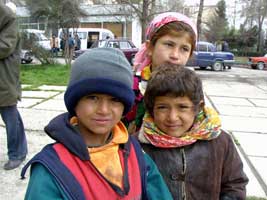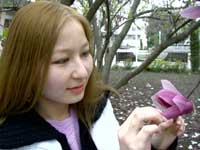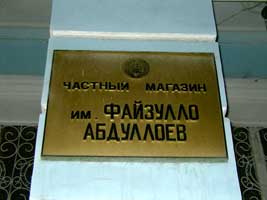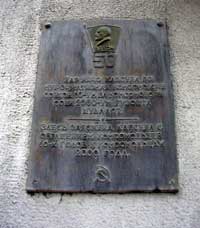Looking for a temple…
In theoretical seminar «Sacred Places of Central Asia»,
which was held in Dushanbe by «Soros Center for Contemporary
According to competitive selection eleven kazakhstanians could visit Tajikistan and to familiarize with varied culture of its territory. They attended a course of lectures about sacral places of the world.
And again we have made sure that historical mixing of Eurasian peoples gives us a right not to identify ourselves with a person of definite nationality, culture and religion. The fact that in every city you can find your own temple is priceless…
After more than one hour flight on airplane of «Tajik Air» which people call «Tragic Air», our group arrived to Dushanbe. No computer or Xerox was on custom and passport officer in airport worked in old fashion. People, delaying impatient of tiredness passengers in long lines, by hand copied our filled in blanks of immigration cards. In our next visit we decided to present them Xerox. Or —at least —paper.
After long procedure we went out from
People
Expressive eyes with long lashes, special tajikian smile and the question «are you looking for something, dear?'…Yes, we want to visit mosque. «Tomorrow'…
A kindness of inhabitants took aback hardening kazakhstanians. As soon as we asked passing woman about the location of a shop, she immediately began to tell us all known variants and then leaving her number she promised to find out the exact address. Policemen took taxi for us and asked a driver to get the place we needed…As soon as we said to waiter about the beauty of magnolia he ran away and when came back he was taking flowers into the hands. But you know, it’s not permitted even to touch it…
Tajikians are very hardworking people. They three times per year sow and then gather in the harvest. They sow the grass even for cattle. And here we realized that our nomadic culture brings up idlers unlike tajikian farming culture…We were proud of our ancestors who at six o’clock in the morning drove out their cattle and at six o’clock in the evening brought it back. Pastures grew scarce and nomads moved to another place. Splendidly!
 From
the other side nobody knows what could happen with tajikians if they
couldn’t cultivate the ground. A pension of two somony
(about 100 tenge) and celery of 30 somony (1,5 thousand
tenge) are not approachable for everybody. Considering prices which
practically are equal with kazakhstanians the fact of survival of some
people is incomprehensible. It is strange, but we saw
no one vagrant…
From
the other side nobody knows what could happen with tajikians if they
couldn’t cultivate the ground. A pension of two somony
(about 100 tenge) and celery of 30 somony (1,5 thousand
tenge) are not approachable for everybody. Considering prices which
practically are equal with kazakhstanians the fact of survival of some
people is incomprehensible. It is strange, but we saw
no one vagrant…
Children near the hotel asked for money to buy bread. As we didn’t have somony we gave them chocolate. They couldn’t believe in miracle…
 Multi-colored
crowd of people in the streets was like splashed out western
bazaar. Beside gypsy asking for alms we met pamirians, old men who
looked like characters from «1000 and 1 night», respectable
officials and strangers like we, foreigners. If you compare
the quantity of civil dressed people and people in national
suits of cause the seconds are in majority. We decided
to do our bit in the development of tajikian culture
too: on the farewell party we wore dzhuraby —national
socks. Long until kneels, multi-colored and very warm, we liked
them more than other elements of tajikian national suit.
Multi-colored
crowd of people in the streets was like splashed out western
bazaar. Beside gypsy asking for alms we met pamirians, old men who
looked like characters from «1000 and 1 night», respectable
officials and strangers like we, foreigners. If you compare
the quantity of civil dressed people and people in national
suits of cause the seconds are in majority. We decided
to do our bit in the development of tajikian culture
too: on the farewell party we wore dzhuraby —national
socks. Long until kneels, multi-colored and very warm, we liked
them more than other elements of tajikian national suit.
You should say Tochikiston, not Tajikistan. This point we understood at first day. Waiters there are «garson-jhon» with typical French pronunciation. So adding the respectful «jhon» to the names we «learned to speak tajik».
Soft «O» letter in tajik language always wins «A». And thinking that in our language they should write «A» in the words we could meet signs: xerAcopy or aviacAmpany. We were impressed by air in Dushanbe. It was soft and sweet. After dusty Almaty it seemed that we were short in something. Where was the smog? There was almost no transport in the evening; pavements were clean and ideal order in parks and in the streets.
 |
Magnolia flower tajiks call tulip-tree. This tree which grew near the «Dushanbe» Hotel was guarding 24 hours a day. We were said: «don’t kill the beauty», and we agreed making photos and shooting to a camera. On the third day of the seminar there was snowing. Strange snow was on the grass and flowers making landscape more harmonious. Small snowman decorated with petals didn’t «live» even a minute. Then we were showed a banana tree, palm, lemons and pomegranates. Locals couldn’t understand the delight of people from «country of karagach«, that was the delight of paradise flora of Tajikistan. |
 |
Sleeping Budda.
 Our
going to a Museum of Tajikistan’s antiquities most
of seminar participants perceived as an annoying need.
Just you must visit this museum, sit into a bus and go. But
what it was the pleasure being there. The museum without glass partitions,
signaling and other kinds of obstacles to scrutinize the values
looked as if it were ennoble excavations of archeologists
when all treasures were already up the ground. Gigantic stone sacrificial
altar, scorched wooden idols, gravestones, boxes with dust, pictures
on stone were in Kastanade’s style. That was strange objects
of
Our
going to a Museum of Tajikistan’s antiquities most
of seminar participants perceived as an annoying need.
Just you must visit this museum, sit into a bus and go. But
what it was the pleasure being there. The museum without glass partitions,
signaling and other kinds of obstacles to scrutinize the values
looked as if it were ennoble excavations of archeologists
when all treasures were already up the ground. Gigantic stone sacrificial
altar, scorched wooden idols, gravestones, boxes with dust, pictures
on stone were in Kastanade’s style. That was strange objects
of
According to seminar’s plan we had to visit famous Gissarian fortress located in thirty minutes from Dushanbe. On the way participants of seminar from Dushanbe paying our attention to green hills with concrete fences around told us a story. Earlier on that height there was a magnificent kishlak of Sharor. About thirteen years ago in one cold winter night there was an earthquake and all people died under climbed down hill. After that tragedy there was survived only one child found safe and sound in his cradle. Nobody knew her name and she was given a new name Sharora. Fourteen years old girl now is leaving in Dushanbe. That time neighbor settlements were not touched on and people said it was a retribution for sins of population leaved in that deserted hamlet. An attempt to dig up people was hopeless. Lifeguards digging ground with spades damaged bodies. As a result was decided to leave the place of mass death. It was rounded with high fence as a communal grave and near there was based a monument…
On the way to the fortress we saw a sign «Observatory»; it was everything that left after military actions…
 After
we reached the Gissarian fortress we got a marriage ceremony
and even took part in. Just married revere this place so as we revere
Eternal Fire. Ancient buildings called for guarding from enemies till
our days instill the reverence and fear. Earthenware crockery’s pieces
were spilled out on the inside hills of the fortress. And Mother-Chinara
who was more than thousand years decorated the out side of brickwork…
After
we reached the Gissarian fortress we got a marriage ceremony
and even took part in. Just married revere this place so as we revere
Eternal Fire. Ancient buildings called for guarding from enemies till
our days instill the reverence and fear. Earthenware crockery’s pieces
were spilled out on the inside hills of the fortress. And Mother-Chinara
who was more than thousand years decorated the out side of brickwork…
«Somebody rang up from Bakteria», hotel’s reception is its own repertoire. Seminar participants visited Cultural center «Baktria» and with pleasure stressed on the development of local art that didn’t depend on strained situation in the country. Painters paint, poets write and life is going on. After we visited painters and wood engravers’ workshops in Dushanbe we were sure in it. Works presented to our attention were so different that could become an «illustration» to the absence of cultural borders.
In spite of all people presented on seminar were from countries of Middle Asia there was any difference in cultures and knowledge. Persons who were sure in this or that question during the seminar made remarks and more precise definitions.
Serik Azhigaly from Kazakhstan told about memorial-cult complexes of Aralo-Kaspian region. Aktyubinsk oblast has a lot of places about which unfortunately knows a few. Magnificent places which entrance with its antiquity are hard-reachable that is why tourists can’t see them yet. Probably it would be better because monuments of disappeared civilizations rounded by café irrevocably loose something valuable. As for me, the tourism development program in Aktyubinsk oblast that so active is being promoted now gives birth to wish to apply to people, to ask them not to do a great deal of harm. I can’t bear changing the history making colored pictures without some facts; it is fine they couldn’t be refuted. Euro-lift of ancient monuments is horrible and shame. But nobody wants near his grave after several centuries will be built hotel or petrol pump…
Our accommodation was in «Dushanbe» hotel. It seemed there never been so many guests in the same time. There was no heating and only sometimes water…
We were surprised and admired by mixed European and Asian service, while taking opposite elements. First days, maid asked if we needed something but didn’t discharge her obligations. But as soon as we joked concerning swollen under the water walls in an hour major repairs of the wall began.
Most shops in Dushanbe work until four o’clock p.m. with a lunch break. During weekends they are closed at two o’clock. At first day of our visit we couldn’t find any open shop or café. All entertainments in Dushanbe beside Internet-clubs were already closed.
Prices for goods and service in Dushanbe are suitable for us but high to locals. Most of offered goods are not reachable for people. With there scanty celery and unemployment people don’t go shopping.
 Looking
for national souvenirs we went to «Shop named after Fayzullo
Abdulloyev». We were impressed by honest in the
name and range of office supplies.
Looking
for national souvenirs we went to «Shop named after Fayzullo
Abdulloyev». We were impressed by honest in the
name and range of office supplies.
Typical for after-soviet countries baraholka in Dushanbe was filled by Chinese goods and Russian foods. Looking for national suit and consumer goods we found tajikian shawls and dresses made in China. «It’s a forgery», then said locals.
In one department skinny old man was sailing apricot-tree combs for
hair and
When we flew back silent crowd of people was standing near the glass airport wall. They looked at us like we got the dream unreachable for them…Once a driver in Dushanbe said: «In 2000 when the peace was done…» Passed a very little time from the war in Tajikistan but country has high developed and probably in several years they would leave Kazakhstan behind. And we were again on board of «Tajik Air’s» craft backing home to Kazakhstan which we were missing much. Nostalgia…And now i know that there is two lands i do love: Kazakhstan and Tajikistan…
Aigerym Tazhi, Aktobe, Kazakhstan
Translated by Dana Shamisheva
Photos by S. Moiseev, R. Afefiev


